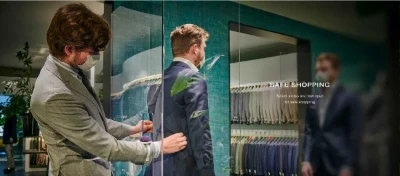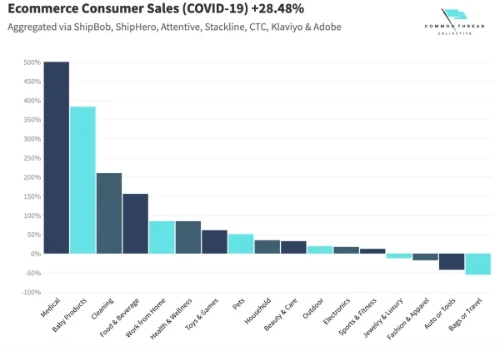U.S. retailers may be about to announce between 20,000 and 25,000 closures in 2020, with 55% to 60% of those situated in America's malls, according to information from Coresight Research. Huge department store brands such as Neiman Marcus and J.C. Penney have already filed for bankruptcy.
Since the rise of the digital age, the number of retail stores has long been forecast to decline. However, the COVID-19 pandemic has dramatically accelerated this process.
Shifting Consumer Behavior
Across the globe, millions of stores were forced to close their doors during the pandemic temporarily. In different countries, many are now cautiously re-opening - yet both rules and customer behaviour has changed. Sixty-five percent of women and fifty-four percent of men said they do not currently feel safe trying on clothes in dressing rooms, according to a survey by retail predictive analytics company First Insight. Due to these worries and the shops own precautions, most fitting rooms remain closed.
Source: SUITSUPPLY
Another significant shift comes from the changes in consumer's disposable income and available leisure time. The rise of e-commerce is old news, and it was generally expected that the closure of bricks-and-mortar fashion stores would further enhance the surge in online shopping. However, from the data provided by Common Thread Collective, e-commerce performance is declining for the category of fashion & apparel. People are spending more on essentials such as health and safety products, shelf-stable goods, foods and others, instead of non-essential products like luxury goods, entertainment or travel.
Source: Common Thread Collective
In addition, consumers have started to reconsider their values and are more mindful of what they are buying. The majority (75%) are limiting food waste, and 67% are shopping more health-consciously. In both cases, 90% of these consumer groups are likely to continue with these habits.
However, despite these changes and understandable caution from shoppers, we believe that when the time is right, consumers will be keen to emerge from their homes and start shopping. Fashion needs to become enticing again. How will you get ready for the rebound, allay fears, and stand out among the competitors?
The New Normal: 3D Innovations
The answer could rely on the recent topic trending in fashion - 3D technologies. Delivering an immersive shopping experience at the same time as making the consumers feel safe might be the biggest challenge for retailers. Besides appealing to the public with guest speakers, in-store campaigns or other strategies, reimagine the future retail experience with 3D technologies and keep the following tips in mind.
Contactless Experience - Healthy, Sanitary and Safe
One of the most significant innovations in fashion technology is the 3D body scanner, which could potentially replace fitting rooms. The 3D body scanner can scan and generate body measurements data in 3 seconds. For ready-to-wear brands, the body analytics data could suggest accurate size recommendations for customers based on the customers’ measurements and personal dressing preferences. Custom apparel brands could use this data instead of human measurement, therefore minimizing contact with their customers.
Taking our Scanatic™ 360 Body Scanner as the reference, people can self-service and operate the scanner directly from their phone without touching any part of the machine. We even developed a new contactless scanning (BETA) interface that could be utilized by the retail stores with the customers' health and safety in mind.
Our client, Fit:Match partnering with one of the biggest U.S. mall owners, Brookfield, is a model case. It's the perfect collaboration of 3D body scanner and brick-and-mortar retail stores. They launched their first pop-up shop at the Baybrook Mall in Houston last November and the results went pretty well.
"We thought, just walking into a store to get fitted is boring," said Patty Hirt, director of retail development at Brookfield Properties, about why the two teamed up. She said many people passing by the Baybrook location would be intrigued to come and see this new technology being used in real-time — younger shoppers, especially. The average age of visitors was 26, she said.

Source: Fit:Match
Experiential value > monetary value
A survey by Retail Dive showed that shoppers much prefer the ability to see, touch, feel and try out items over shopping online. New York-based consumer psychologist Peter Noel Murray believes this type of browsing can give us a positive psychological boost. In the current climate, the next best thing is the use of digital 3D technologies.
Retailers can turn window shopping into interactive shopping and optimize the experience for customers. Photo-realistic 3D displays can be designed, featuring exact digital copies of garments. Customers can play and interact with the clothes by zooming in to see the details, spinning around to different angles, or even change the fabrics, trims and styles of the designs. Combining 3D body scanning technology with 3D clothing, customers could also virtually try on all the customized designs with an exact digital copy of their own body through our "Virtual Try On" service, scheduled for launch at the end of 2021.
Sustainability
As well as having to think about how much food they buy and throw away, during the lockdown, people also saw a stark example of how manufacturing pollution affects the climate. Those photos of dolphins serenely floating in Venice canals may have been fake - but the reports of the pollution clearing over China were not. Digital clothing is the obvious answer to the waste entailed in making a physical product. Digital sampling is used by many huge brands, to avoid making and re-making ideas up in cloth which is then thrown away. And customers may also avoid purchasing mountains of ill-fitting clothing which they may later discard, by using the "Virtual Try On" service. Much more about that here.

So, despite the problems the pandemic has brought, it's not all doom and gloom. We predict that fashion shops will spring back from the experience - more robust, and perhaps even more thoughtful and creative than ever.


